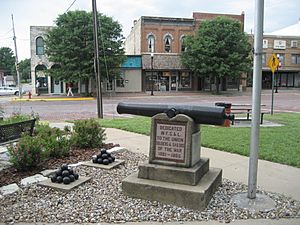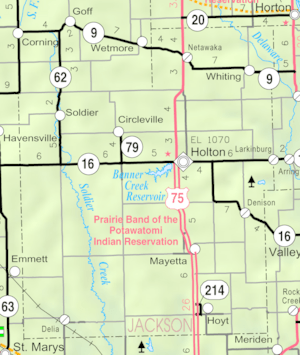Holton, Kansas facts for kids
Quick facts for kids
Holton, Kansas
|
|
|---|---|
|
City and County seat
|
|

Downtown Holton (2007)
|
|

Location within Jackson County and Kansas
|
|

|
|
| Country | United States |
| State | Kansas |
| County | Jackson |
| Founded | 1856 |
| Platted | 1857 |
| Incorporated | 1859 |
| Named for | Edward Holton |
| Area | |
| • Total | 2.76 sq mi (7.15 km2) |
| • Land | 2.68 sq mi (6.93 km2) |
| • Water | 0.08 sq mi (0.22 km2) |
| Elevation | 1,056 ft (322 m) |
| Population
(2020)
|
|
| • Total | 3,401 |
| • Density | 1,232.2/sq mi (475.7/km2) |
| Time zone | UTC-6 (CST) |
| • Summer (DST) | UTC-5 (CDT) |
| ZIP code |
66436
|
| Area code | 785 |
| FIPS code | 20-32825 |
| GNIS ID | 485594 |
Holton is a city in Jackson County, Kansas, United States. It is also the county seat, which means it is the main town where the county government is located. In 2020, about 3,401 people lived in Holton.
Contents
History of Holton
Holton was founded in 1856 by a group of settlers from Milwaukee, Wisconsin. These settlers were known as "Free State" supporters. This meant they were against slavery and wanted Kansas to become a free state. They were helped by Edward Dwight Holton, who was an abolitionist (someone who wanted to end slavery). The town was named in his honor.
The settlers traveled in six covered wagons pulled by oxen. They met General James H. Lane and followed his "Jim Lane Road" into Kansas. They chose the area near two streams, which are now called Banner Creek and Elk Creek. They built a log house that could also be used as a fort, known as Jim Lane's Fort.
In 1857, the town's lots were officially measured and mapped out. The county where Holton is located was first called Calhoun County. This name honored a senator who supported slavery. However, in 1859, the name was changed to Jackson County. Holton became the county seat in 1858. The first courthouse was built in 1872, and the current one was finished in 1921.
In 1859, a famous abolitionist named John Brown passed through Holton with a group of escaped slaves. This event led to a small conflict called the Battle of the Spurs.
By 1859, Holton had grown to include seven homes, a store, a blacksmith shop, and a sawmill. The city was officially made a city (incorporated) in 1859. Its population grew from 291 people in 1857 to 1,936 by 1860.
Later, in 1879, people in Jackson County wanted to start a university in Holton. A wealthy mining owner named A. C. Campbell helped fund it, so it was named Campbell University. It later merged with other colleges and eventually closed in 1933. Today, Holton High School is located where the college used to be.
Holton's Geography
Holton covers a total area of about 2.78 square miles (7.15 square kilometers). Most of this area is land, with a small part being water.
Climate in Holton
Holton has a climate with hot, humid summers. The winters are usually mild to cool. This type of weather is known as a humid subtropical climate.
| Climate data for Holton, Kansas (1991–2020 normals, extremes 1902–1904, 1913–1917, 1951–present) | |||||||||||||
|---|---|---|---|---|---|---|---|---|---|---|---|---|---|
| Month | Jan | Feb | Mar | Apr | May | Jun | Jul | Aug | Sep | Oct | Nov | Dec | Year |
| Record high °F (°C) | 75 (24) |
81 (27) |
89 (32) |
93 (34) |
99 (37) |
109 (43) |
110 (43) |
110 (43) |
109 (43) |
97 (36) |
85 (29) |
74 (23) |
110 (43) |
| Mean maximum °F (°C) | 62.3 (16.8) |
67.7 (19.8) |
77.8 (25.4) |
85.2 (29.6) |
89.7 (32.1) |
93.3 (34.1) |
98.5 (36.9) |
98.2 (36.8) |
93.3 (34.1) |
86.3 (30.2) |
73.4 (23.0) |
64.0 (17.8) |
100.4 (38.0) |
| Mean daily maximum °F (°C) | 37.2 (2.9) |
43.0 (6.1) |
54.1 (12.3) |
64.2 (17.9) |
73.7 (23.2) |
82.8 (28.2) |
87.5 (30.8) |
86.3 (30.2) |
78.7 (25.9) |
66.7 (19.3) |
53.0 (11.7) |
40.9 (4.9) |
64.0 (17.8) |
| Daily mean °F (°C) | 26.2 (−3.2) |
31.2 (−0.4) |
41.7 (5.4) |
52.1 (11.2) |
62.5 (16.9) |
72.3 (22.4) |
76.8 (24.9) |
75.0 (23.9) |
66.8 (19.3) |
54.1 (12.3) |
41.3 (5.2) |
30.3 (−0.9) |
52.5 (11.4) |
| Mean daily minimum °F (°C) | 15.2 (−9.3) |
19.5 (−6.9) |
29.2 (−1.6) |
40.0 (4.4) |
51.3 (10.7) |
61.8 (16.6) |
66.1 (18.9) |
63.7 (17.6) |
54.8 (12.7) |
41.4 (5.2) |
29.7 (−1.3) |
19.6 (−6.9) |
41.0 (5.0) |
| Mean minimum °F (°C) | −4.9 (−20.5) |
1.3 (−17.1) |
8.2 (−13.2) |
23.7 (−4.6) |
35.6 (2.0) |
48.6 (9.2) |
54.9 (12.7) |
51.5 (10.8) |
39.4 (4.1) |
25.2 (−3.8) |
13.4 (−10.3) |
2.2 (−16.6) |
−8.6 (−22.6) |
| Record low °F (°C) | −22 (−30) |
−23 (−31) |
−21 (−29) |
5 (−15) |
22 (−6) |
40 (4) |
43 (6) |
40 (4) |
29 (−2) |
14 (−10) |
−7 (−22) |
−23 (−31) |
−23 (−31) |
| Average precipitation inches (mm) | 0.79 (20) |
1.33 (34) |
2.17 (55) |
3.72 (94) |
4.98 (126) |
4.88 (124) |
4.76 (121) |
4.35 (110) |
3.77 (96) |
3.33 (85) |
1.84 (47) |
1.46 (37) |
37.38 (949) |
| Average precipitation days (≥ 0.01 in) | 4.4 | 4.9 | 7.0 | 9.5 | 11.4 | 9.8 | 9.5 | 8.6 | 8.3 | 7.3 | 6.2 | 4.4 | 91.3 |
| Source: NOAA | |||||||||||||
Holton's Population
| Historical population | |||
|---|---|---|---|
| Census | Pop. | %± | |
| 1890 | 2,727 | — | |
| 1900 | 3,082 | 13.0% | |
| 1910 | 2,842 | −7.8% | |
| 1920 | 2,703 | −4.9% | |
| 1930 | 2,705 | 0.1% | |
| 1940 | 2,885 | 6.7% | |
| 1950 | 2,705 | −6.2% | |
| 1960 | 3,028 | 11.9% | |
| 1970 | 3,063 | 1.2% | |
| 1980 | 3,132 | 2.3% | |
| 1990 | 3,196 | 2.0% | |
| 2000 | 3,353 | 4.9% | |
| 2010 | 3,329 | −0.7% | |
| 2020 | 3,401 | 2.2% | |
| U.S. Decennial Census | |||
Holton is part of the larger Topeka, Kansas area.
Population in 2020
The 2020 United States census counted 3,401 people living in Holton. There were 1,410 households and 784 families. The population density was about 1,271 people per square mile. Most residents (83.68%) were white. Other groups included African American (1.82%), Native American (3.32%), and Asian (0.59%). About 8.91% of the population was Hispanic or Latino.
About 29.8% of households had children under 18. Many households (38.6%) were married couples. About 38.9% of households were individuals living alone. The average age in Holton was 39.2 years. About 24.7% of the population was under 18, and 21.7% were 65 or older.
Population in 2010
In the census of 2010, Holton had 3,329 people. There were 1,442 households. The city's population density was about 1,233 people per square mile. The racial makeup was mostly White (89.7%). Other groups included African American (1.1%), Native American (3.4%), and Asian (0.6%). About 4.9% of the population was Hispanic or Latino.
About 29.6% of households had children under 18. The average household had 2.23 people. The median age was 40.2 years. About 24.5% of residents were under 18, and 20.5% were 65 or older.
Education in Holton
Students in Holton attend schools in the Holton USD 336 public school district. The main high school is Holton High School.
Notable People from Holton
Holton has been home to several notable people, including:
- Case Broderick, a politician
- Bill James, a famous baseball writer and statistician
- Lynn Jenkins, a U.S. Congresswoman
- Kendall McComas, a child actor
- Harold B. Minor, a diplomat
- Danny J. Petersen, who received the Medal of Honor
- Frank C. Pomeroy, a state legislator
- Pat Roberts, a U.S. Senator
- Robin Utterback, an artist
- Bernice T. Van der Vries, an Illinois state legislator
See also
 In Spanish: Holton (Kansas) para niños
In Spanish: Holton (Kansas) para niños

